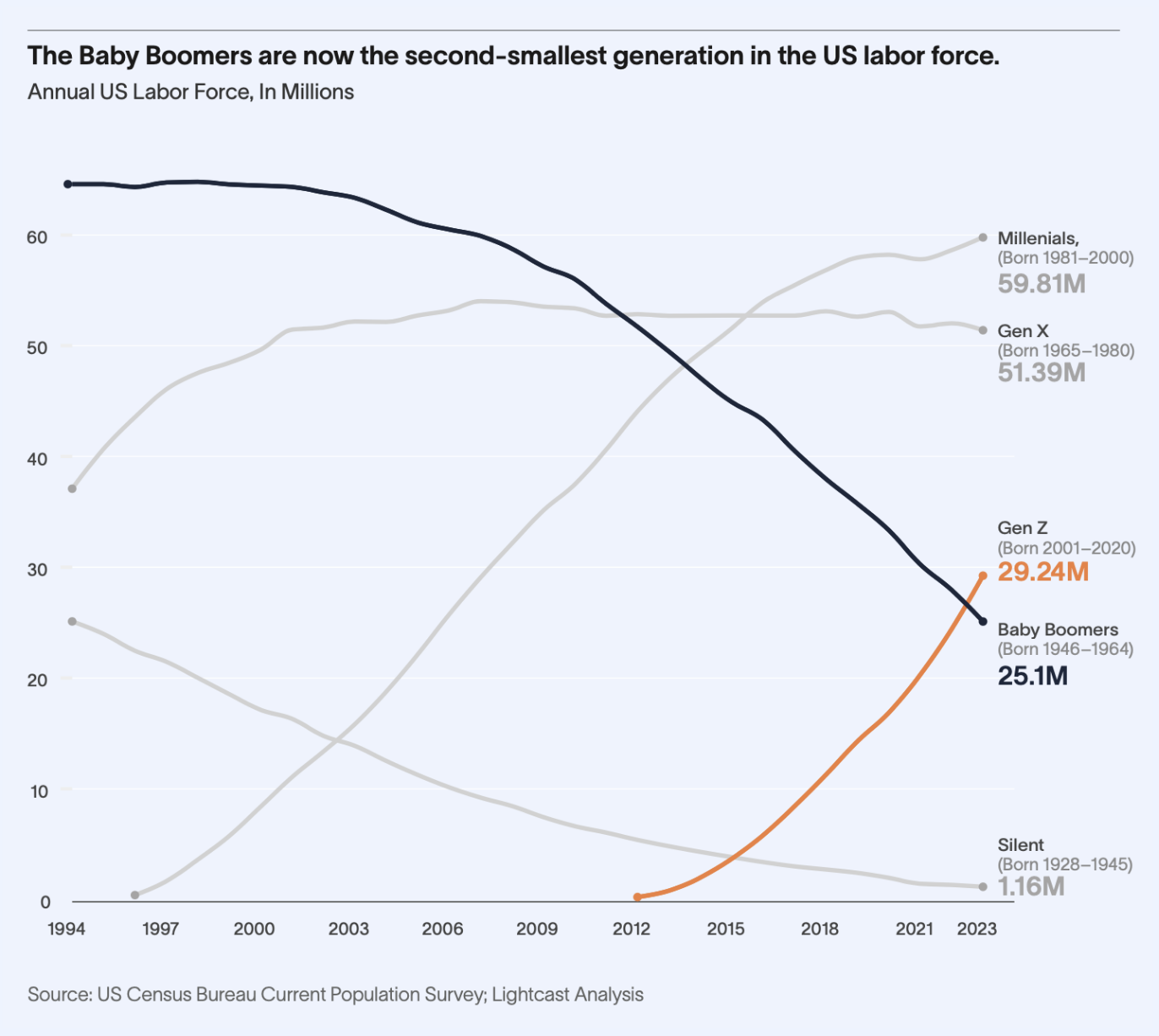As Baby Boomers continue their steady march toward retirement, the labor market is poised for a significant shift. But what, exactly, are these older workers doing before they exit the workforce? And what kind of gaps will they leave behind?
We explore these questions through the lens of our Rising Storm research, which examines the hidden churn and structural transitions happening across the U.S. labor market. Looking specifically at people aged 55–64 and 65+, we found that the years leading up to retirement look a lot different from what you might expect.

Less Labor, More Leadership
One of the clearest trends in the data is a shift away from physically demanding jobs as workers near retirement age. The presence of people aged 55–64, and even more so for those over 65, in occupations in construction, manufacturing, and repair begin to fall off significantly.
Instead, we see people aged 55+ in many less physically intensive roles, often in fields that leverage experience and expertise. Management, administrative support, and sales are some of the most common jobs for workers nearing retirement. These roles allow older workers to remain active contributors to their organizations without the physical strain associated with frontline or manual labor.
Other frequent occupations for older adults include industrial-organizational psychologists, survey researchers, and travel agents. These positions not only reflect a shift in physical intensity, but often represent advisory, mentoring, or analytical roles where wisdom and institutional knowledge are key.
A Rise in Self-Employment
The transformation isn’t just about job type—it’s also about how older workers choose to work.
Compared to the broader workforce, people aged 55 and older are significantly more likely to be self-employed or classified as “extended proprietors”. In fact, only 60% of workers over 55 are in standard employment, compared to 69% across all age groups. Meanwhile, 30% of older workers are engaged in self-employment or economic activity outside of their primary job—often investing, consulting, or running their own small businesses.
This suggests that many older workers are staying engaged in the economy on their own terms. Whether it's for flexibility, autonomy, or passion projects, they are building post-career paths that look different from traditional 9-to-5 jobs. In this phase of their careers, work becomes not just a necessity, but a choice.
Where Gaps Will Appear
As these older workers begin to exit the labor market, they won’t just leave behind vacancies. They’ll leave behind gaps. Many of the roles they occupy are highly specialized or slow to refill, creating real challenges for continuity and succession planning.
For example, Lightcast data highlights several occupations where older workers are disproportionately represented and where retirements could have an outsized impact:
Property Appraisers – These professionals often have years of training and certification, making rapid replacement difficult.
Psychologists (especially I/O Psychologists) – These roles rely heavily on graduate-level education and accumulated experience.
Musical Instrument Repairers – A niche field requiring hands-on craftsmanship and long-term apprenticeship.
Similarly, Lightcast data shows that, in addition to psychologists and musical instrument repairers, the occupations most reliant on people above the age of 55 are involved in the funeral industry - funeral attendants, crematory operators, and embalmers.
These are not jobs that can be filled overnight. As Boomers retire, organizations across industries may find themselves scrambling to maintain institutional knowledge and fill highly specific roles that lack immediate backfill options.
Implications for Employers and Policymakers
Understanding what older workers are doing before they retire isn’t just a curiosity—it’s a strategic imperative.
Employers should be asking:
How dependent are we on older talent for mission-critical roles?
Are we providing flexible or alternative work arrangements that appeal to older professionals who might otherwise leave?
Do we have mentorship or succession strategies in place to transfer knowledge?
At the same time, policymakers and workforce planners need to prepare for increased demand in certain occupations, especially those tied to healthcare, skilled trades, and advisory roles. Failing to act now could mean longer-term talent shortages down the road.
The Bottom Line
Older workers are transitioning into roles that reflect their experience, preferences, and physical capabilities. They're not just winding down. They're actively shaping the economy in their final working years. Whether through leadership positions, consulting, or entrepreneurship, they’re finding new ways to stay productive and purposeful.
As they leave the workforce, the challenge will be preserving the value, skills, and wisdom these workers carry with them. The companies and institutions that plan ahead for this transition will be better positioned to weather the demographic and economic changes already underway.
About Data Snacks
Data Snacks is an ongoing series from Cole Napper, VP of Research & Thought Leader at Lightcast. Every week, we deliver bite-sized, data-driven insights into the labor market, highlighting the trends, talent, and technologies shaping the future of work.




